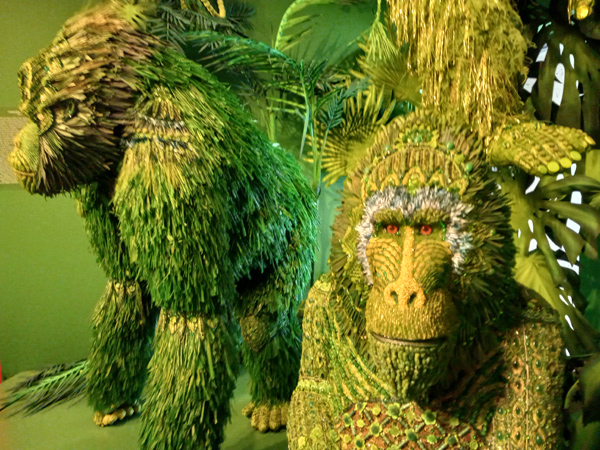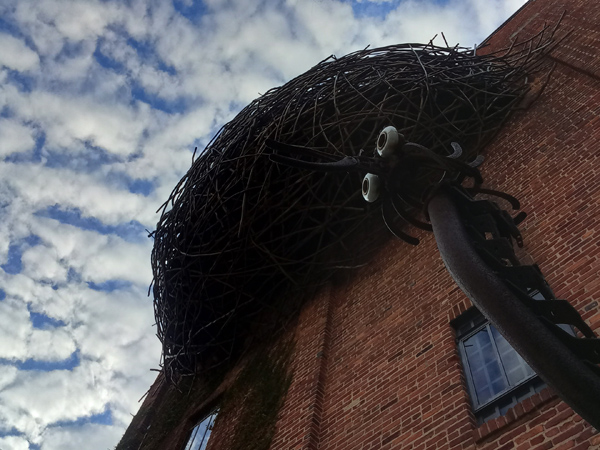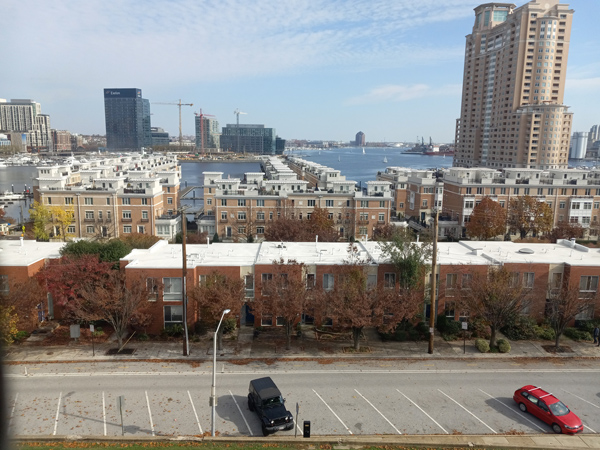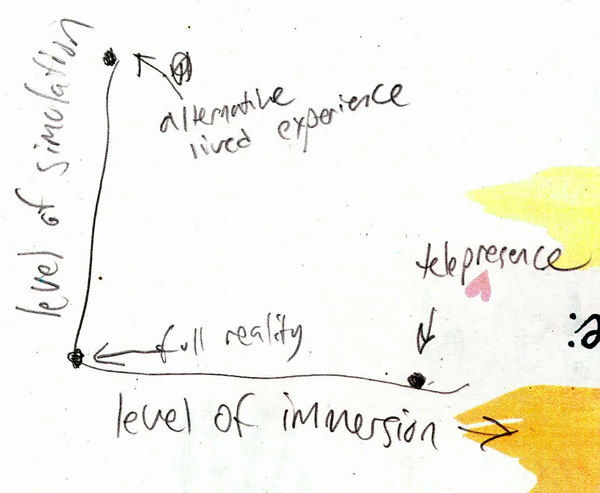|
|
|
visionary art
Saturday, November 12 2022
location: a first floor room, Biddle Street Inn, Baltimore, Maryland
[REDACTED]
After a couple hours of leisurely bed-based activities like solving the New York Times Spelling Bee, Gretchen and I went out for at 11:00am brunch at Liora, a fancy vegan restaurant near the harbor. It was in the first floor of a modest skyscraper in a double-height space with huge concrete support pillars punctuating the space. I kept thinking about all the thermal mass these provided. There had been no coffee and no way to make it at the Biddle Street Inn, so that was the thing I was most strongly craving. Strangely, Liora didn't have the technology to make us anything more elaborate than french press coffee. I'm not a big fan of brunch foods, but I'd been looking forward to Liora's biscuits and gravy, which I hoped would be like what turned out to be vegan gravy with non-vegan biscuits I'd had once in Asheville, North Carolina. Those biscuits had been oily and very flakey, but these biscuits were somewhat disappointing: they had a texture and consistency so similar to birthday cake that I assumed they were also sweet, though I don't think they were. The tempeh gravy, on the other hand, was great. It was even a little spicier than one normally encounters at an American brunch.
We'd arrived at about 11:00am and had been the first customers. But by the time we left, there were only two other occupied tables, which doesn't seem very promising for an urban brunch crowd.
Our next destination was the nearby Visionary Art Museum, which Gretchen has been raving about for years. It features the work of various outsider artists and people who don't consider themselves artists. Since covid, the museum has been making visitors schedule their visits in order to keep it from getting too crowded, and we were a little early for ours. So we strolled around nearby Federal Hill Park, enjoying the perfect sunny weather. A house at a prime location atop the hill (39.27855994798842N, 76.60749416122518 W) near the southeast corner of the park was having an open house, so Gretchen and decided to look inside and see what a million dollar house in Baltimore looked like. There were some nice things about it, like the kitchen tiled with rough red brick and some of the bathrooms. But some of the rooms, particularly those upstairs, tended to ramble and were in desperate need of renovation. Strangely, one of the bathrooms didn't have a door. But the views of the harbor were amazing. The constant stream of randos walking into the park, though, seemed like a big negative.
I'd eaten a big nugget of cannabis before we'd climbed up Federal Hill, but I would be in the Visionary Museum for an hour or so before it kicked in. In the meantime, we walked around and looked at all the amazing things people come up with when they're not necessarily trying to be famous artists. I imagine it's hard to draw a firm line between who is outsider artist and who is not, and the art itself often doesn't provide much of a clue. Take for example the collection of life-size green apes rendered in plant material and shiny beads. Perhaps the attention to detail and obvious obsession that went into it gives it away as the product of an outsider artist. There's usually some gritty hook to the story of an outsider artist. Sometimes he toiled as a janitor and could only work on his art in the evenings. Or maybe he was in prison and was forced to make art from colored threads removed from old socks (true story).
At some point we found ourselves watching a movie about an old woman who makes art mostly by grouting various solid objects together to form walls and floors, something she's been doing for many years, producing a rambling showcase of her work that she can charge admission to see. Her sister seems jealous of her, not of her talents, but of the money she makes giving tours. Her petty obsession with money was reminding Gretchen and me of the people in my mother's family. I think this was around the time the cannabis kicked in.
After that, we spent a long time reading the stitched fabric tapestries made by Esther Krinitz, a Jewish Holocaust survivor who, along with her sister, were the only Jews from the Polish village of Mniszek to survive after the Germans arrived because they fled the village, acted as though they couldn't understand German, and impersonated itinerate Roman Catholic farm women. The stories methodically depicted (and narrated with text stitched into the tapestries) were heartbreaking, full of humiliation, murder, theft, deception, lethal obedience, and occasional amazing instances of good luck. All of these horrors take place against the often beautiful backdrop of rural Poland, a place where the cycles of nature continue no matter what horrors are happening among the humans living there. But it turns out that even nature takes a side in this conflict, and it isn't for the Nazis. One of Krinitz's tapestries tells the story of yet another time the Nazis were hassling our heroine and the honeybees suddenly started attacking the invaders, allowing Krinitz to escape. I know from my childhood that honeybees are extremely docile and will permit all sorts of human interactions. So the fact that they decided to attack the Nazis suggests they'd decided, perhaps in an intelligence-of-the-hive sense, that the Nazis were a problem and needed to go. This makes sense if you think about it. As collectives, honeybees make all sorts of sophisticated decisions and pursue elaborate strategies in order to survive. It would make sense that they would be able to detect something undesirable happening in their environment, identify the cause, and take action against it. This made me wonder if invading human armies often encounter unusual resistance from stinging communal insects. Perhaps so!
Back in our hotel, we had a little downtime this afternoon. I was still fully feeling the effects of the cannabis I'd eaten and would've really appreciated a coffee drink. But the only beverage available in our room was water. So I drank a fair amount of that. Eventually Gretchen went off to see if there was a performance we could attend of the Baltimore Philharmonic, which was right there in our neighborhood. (It turned out there wasn't.) While she was out, Gretchen got me an oatmilk latte from Dunkin Donuts. It was exactly what I wanted to be drinking!
Eventually a kooky cannabis idea occurred to me and I had to write it down. The idea was of a two-dimensional continuum where one dimension was "level of simulation" and the other was "level of immersion."
Eventually evening arrived and Gretchen and I got up and went to dinner. The plan was to have Ethiopian food at Dukem, a restaurant in the neighborhood. But when we arrived, its dining room was already crowded and there were no tables. No problem! One of the staff unhooked the chain blocking access to a whole separate upstairs dining room that had its own bar and murky colored lighting that (in my still-cannabis-altered-state) made it feel like a cross between an acid trip and a simulation. We didn't get a lot of attention up there as the only diners in that dining room. But eventually another couple was seated nearby and a waitress who seemed more on-the-ball took over. I thought the veggie plate we ordered was very good, but Gretchen (who is particular about her Ethiopian food) said she probably would never come back to this place. When I asked our waitress about the beer options, I was given the following choice: Stella or Ethiopian beer. Naturally, I picked the latter.
After dinner, we strolled around the neighborhood, eventually finding Leon's (the bar recommended by the audience to Randy Rainbow last night), though we didn't go in.

Downtown Baltimore near Liora.

Amazing green gorillas at the Visionary Art Museum.

A creepy uncanny valley baby at the Visionary Art Museum.

A sculptural bird with a nest "built" onto the side of one of the Visionary Art Museum's buildings. Click to enlarge.

Baltimore Harbor from Federal Hill. Click to enlarge.

The two-dimensional stoner diagram I drew in our hotel room.
For linking purposes this article's URL is:
http://asecular.com/blog.php?221112 feedback
previous | next |





